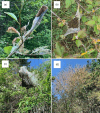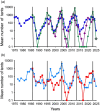Long-term population dynamics of western tent caterpillars: History, trends and causes of cycles
- PMID: 40660707
- PMCID: PMC12484394
- DOI: 10.1111/1365-2656.70104
Long-term population dynamics of western tent caterpillars: History, trends and causes of cycles
Abstract
This is a story of unique long-term studies of the population ecology of a gregarious, cyclic forest insect, the western tent caterpillar (WTC), Malacosoma californicum pluviale. Early work by W.G. Wellington proposed that variation in the 'quality' and activity of larvae and moths influenced their population ecology. Our subsequent studies monitored six WTC populations over 29-50 years in south-western BC to determine the consistent characteristics of cyclic population dynamics. The six studied populations fluctuated more or less in synchrony with an eight to 11-year periodicity. Fecundity and tent size (an indication of early larval survival) increased with population increase and declined several years before the population peak. Fecundity and tent size were positively related to the population growth rate and declined before the population peak. Mortality from a baculovirus was high at peak densities, and the rate of population growth was negatively related to infection levels. Resistance to the virus varied among families and was higher following the epizootic at peak host density. Factors that might influence changes in fecundity were explored. Viral resistance was not related to moth fecundity, but sublethal effects as a result of surviving virus exposure could reduce fecundity. Declines in fecundity and tent size prior to the peak density could be a result of reduced foliage availability and quality from induced effects of larval feeding. Introduction and cropping experiments were unsuccessful at creating out-of-phase populations, and introduced insects appeared to carry the 'quality' of the source populations and declined synchronously with them. Warming temperatures influence the phenology of egg hatch and leaf development, but field experiments show that WTC larvae are resilient to this variation. No signal of an influence of a warming climate was apparent in long-term data. Longterm field observations indicate that changes in fecundity and viral infection can drive population cycles and inform the theory of cyclic dynamics. The early focus on variation among individuals was a prelude to the eco-evo thinking that has become accepted today but should include both genetic and phenotypic change as being relevant.
Keywords: Malacosoma californicum pluviale; baculovirus; eco‐evo; forest Lepidoptera; host resistance; long‐term data; phenotypic plasticity; population cycles.
© 2025 The Author(s). Journal of Animal Ecology published by John Wiley & Sons Ltd on behalf of British Ecological Society.
Conflict of interest statement
The authors declare no conflicts of interest.
Figures





References
-
- Barraquand, F. , Louca, S. , Abbott, K. C. , Cobbold, C. A. , Cordoleani, F. , DeAngelis, D. L. , Elderd, B. D. , Fox, J. W. , Greenwood, P. , Hilker, F. M. , Murray, D. L. , Stieha, C. R. , Taylor, R. A. , Vitense, K. , Wolkowicz, G. S. K. , & Tyson, R. C. (2017). Moving forward in circles: Challenges and opportunities in modelling population cycles. Ecology Letters, 20, 1074–1092. - PubMed
-
- Bassar, R. D. , Coulson, T. , Travis, J. , & Reznick, D. N. (2021). Towards a more precise—And accurate—View of eco‐evolution. Ecology Letters, 24, 623–625. - PubMed
-
- Berryman, A. A. (1992). The origins and evolution of predator‐prey theory. Ecology, 73, 1530–1535.
-
- Berryman, A. A. (1996). What causes population cycles of forest Lepidoptera? Trends in Ecology & Evolution, 11, 28–32. - PubMed
-
- Boots, M. , & Haraguchi, Y. (1999). The evolution of costly resistance in host‐parasite systems. The American Naturalist, 153, 359–370. - PubMed
Publication types
MeSH terms
LinkOut - more resources
Full Text Sources

